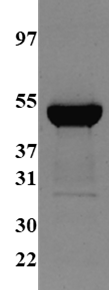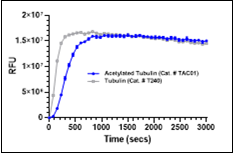Acetylated Tubulin protein Source: Porcine Brain
Acetylated Tubulin protein Source: Porcine Brain
Product Uses Include
- Acetylated Tubulin Polymerization Studies
- De-acetylation of Acetylated Tubulin Studies
- Acetylated Tubulin MAP Binding Studies
- Mass Spectroscopy of Acetylated Tubulin Studies
Material
The acetylated tubulin protein (Cat. # TAC01) was prepared from porcine brain by adaptation of the method Shelanski et al (6). Further purification was achieved by cation exchange chromatography, and acetylation of K40 of α-tubulin was facilitated by the αTAT1 protein as reported in Friedmann et al and Howes et al (7, 8). Tubulin consists of a heterodimer of one alpha and one beta isotype, each tubulin isotype is 55 kDa in size (see Figure 2). Typically, the molar equivalent of tubulin is defined as the heterodimer which has a molecular weight of 110 kDa. The protein is supplied as a white solid.
Purity
A 10 µg sample of acetylated tubulin protein (Cat. # TAC01) purity is determined by scanning densitometry of Coomassie Blue-stained protein on a 4-20% polyacrylamide gradient gel. Acetylated tubulin protein was determined to be 90% pure.

Figure 2: A 10 µg sample of acetylated tubulin protein (Cat. # CS-TAC01) purity is determined by scanning densitometry of Coomassie Blue-stained protein on a 4-20% polyacrylamide gradient gel. Acetylated tubulin protein was determined to be 90% pure. Protein quantitation was performed using the Precision Red Protein Assay Reagent (Cat. # ADV02). Molecular weight markers are from Invitrogen (Mark 12).
Biological Activity
The biological activity of acetylated tubulin is assessed by a tubulin polymerization assay (Fig. 3). The results indicate K40-Acetylated tubulin shows slightly slower kinetics than native tubulin but it reaches a similar equilibrium point after 900s.

Figure 3. Acetylated Tubulin Polymerization Assay
Each 50 ml well reaction contains 2.5 mg/ml Acetylated tubulin (Cat. # CS-TAC01) (n=2) or 2.5 mg/ml tubulin (Cat. # T240) (n=2). Excitation was at 360 nm and emission at 420 nm measured on an iD5 multi-mode microplate reader (Molecular devices) over 50 minutes at 37oC.
References
- Barra H.S., et al. (1974) Biochem. Biophys. Res. Commun.60:1384-1390.
- Eshun-Wilson L., et al. (2019) PNAS 116:10366-10371.
- Dompierre et al. (2007) J . Neurosci. 27:3571-3583.
- Reed et al. (2006) Curr. Biol. 16:2166-2172.
- Nekooki-Machida and Hagiwara. (2020) Med Mol Morphol. 53:191–197.
- Shelanski ML, et al. (1973) PNAS 70: 765-768 .
- Shida T.., et al. (2010) PNAS 107: 21517-21522
- Howes SC., et al. (2014) Mol. Biol. Cell. 25:257-266
For product Datasheets and MSDSs please click on the PDF links below. For additional information, click on the FAQs tab above or contact our Technical Support department at tservice@cytoskeleton.com
If you have any questions concerning this product, please contact our Technical Service department at tservice@cytoskeleton.com.
If you have any questions concerning this product, please contact our Technical Service department at tservice@cytoskeleton.com.
















